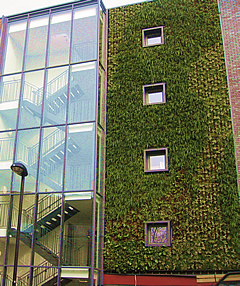
by Shane Henson — July 27, 2012—Scientists at the Universities of Birmingham and Lancaster in the U.K. report that cities could see a massive 30% reduction in pollution through “greening up” their streets. Trees, bushes and other greenery growing in the concrete-and-glass “urban canyons” of cities in the U.K. and abroad would deliver cleaner air at the roadside where most people are exposed to the highest pollution levels, and could be implemented street-by-street without the need for large-scale and expensive initiatives, say the scientists.
Research on the subject was funded through the Engineering and Physical Sciences Research Council’s Sustainable Urban Environment program, and published in the journal Environmental Science and Technology.
“Up until now, every initiative around reducing pollution has taken a top-down approach—scrapping old cars, adding catalytic converters to cars, and bringing in the congestion charge—some of which have not had the desired effect, says University of Birmingham’s School of Geography, Earth and Environmental Sciences.
The researchers found that, because pollution cannot easily escape street canyons, “green walls” of grass, climbing ivy and other plants have a better opportunity than previously thought to act as an air pollution filter. Instead of reducing pollution by 1 or 2%, reductions of more than 10 times this magnitude could be achieved.
Using a computer model that captures the trapping of air in street canyons, as well as the hundreds of chemical reactions that can affect pollution concentrations, the research team could distinguish the effects of plants in canyons from those of plants in parks or on roofs. Green walls emerged as clear winners in terms of pollutant removal. Street trees were also effective, but only in less polluted streets where the tree crowns did not cause pollution to be trapped at ground level, they say.
Using plants to reduce pollution at the street level does require that they do not expire in the extreme environment of today’s cities, however.
“More care needs to be taken as to how and where we plant vegetation in our towns and cities, so that it does not suffer from drought, become heat stressed, vandalized, or interact negatively with other aspects of our urban areas, and can carry out the very important job of filtering our air,” says Dr. Tom Pugh of Lancaster University.




